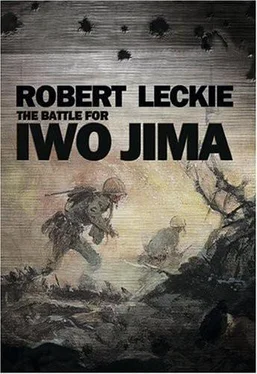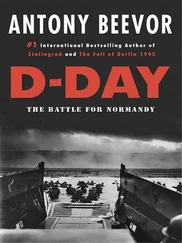Chapter 8
’TILL THE LAST MAN
The night that the Marine patrol reached the sea, General Tadamichi Kuribayashi gave Tokyo its first hint of approaching defeat.
“All surviving units have suffered heavy losses,” he declared in a message. “I am very sorry that I have let the enemy occupy one part of Japanese territory, but I am taking comfort in giving him heavy losses.”
The general and his men were indeed doing just that. Even though only about 1,500 Japanese soldiers remained, they were still fighting stubbornly. On the right, where General Cates’s 4 Division was fighting, there were numerous enemy pockets still holding out. Here General Cates tried to reach Major General Sadusi Senda, commander of the Japanese 2 Mixed Brigade, which opposed the 4. He prepared a surrender appeal which said:
“You have fought a gallant and heroic fight, but you must realize Iwo Jima has been lost to you. You can gain nothing by further resistance, nor is there any reason to die when you can honorably surrender and live to render valuable service to your country in the future. I promise and guarantee you and the members of your staff the best of treatment. I respectfully request that you accept my terms of honorable surrender.”
It is not known if General Senda ever received this message. Nor was his body ever found when, on March 16, the 4 turned from killing enemy soldiers to counting their corpses. On that date all resistance on the right, or eastern, flank ended. Three days later, the battered, riddled 4 took ship for Hawaii. It had suffered 9,098 casualties on Iwo Jima, and 1,806 of these men were buried there. In just 14 months, the 4 Marine Division had fought three major battles and had suffered 17,722 casualties. So the 4 sailed away from that black, bloody curse of an island, never to enter combat again in World War Two.
On the left, however, the 5 and 3 were still in battle. Here the remaining enemy soldiers were under the command of Colonel Masuo Ikeda. They were pressed into a square mile of tumbled ravines and gorges. One of these, about 700 yards long and from 200 to 300 yards wide, became the scene of Kuribayashi’s last stand. It was at first impossible to use tanks or other vehicles, and the savagery of the fighting gave the area the name of “Bloody Gorge.”
On March 13 a Marine patrol came very close to capturing General Kuribayashi in a cave within the Gorge. The Americans peered into the cave and the general’s orderly quickly blew out the candles and wrapped his chief in a blanket. Some of the Marines ventured inside. They paused, peered around, and then departed—and the heart of the general’s orderly ceased its mad pounding.
Next day Bloody Gorge shrank still smaller. On that day, Private Franklin Sigler led a charge against the gun position which had barred his company’s advance for several days. He reached it unhurt, knocked it out and killed its crew. Immediately, enemy fire came plunging down on him from Japanese caves and tunnels. Sigler responded by scaling the rocks and destroying these positions as well. But he was seriously wounded in the skirmish. Still, he refused evacuation and continued to direct American fire into the Japanese positions. Under fire he also carried three wounded comrades to safety, and he went to the rear himself only when ordered to do so. Sigler won the Medal of Honor for his actions, which played a large part in the destruction of the defenders of the Gorge—Japan’s famous 145 Infantry Regiment.
Kuribayashi’s concern now was for the 145’s regimental flag. In the Japanese army a unit’s colors were sacred. If they were ever lost, the unit’s name was stricken from the army rolls in disgrace. Japanese officers very readily sacrificed their lives for their colors, and to be named to the color guard was the highest honor which could befall a Japanese soldier. Because of this, General Kuribayashi asked Colonel Ikeda how much longer the regimental flag would be safe.
“Maybe a day,” the colonel replied, and Kuribayashi said: “Burn it. Do not let it fall into the hands of the enemy.” Ikeda obeyed, reporting from his command post: “Here we burnt our brilliant regimental flag completely. Good-by.”
A few days later, General Erskine attempted to persuade Colonel Ikeda to surrender. His appeal said: “The fearlessness and indomitable fighting spirit which has been displayed by the Japanese troops on Iwo Jima warrants the admiration of all fighting men. You have handled your troops in a superb manner, but we have no desire to annihilate brave troops who have been forced into a hopeless position. Accordingly, I suggest that you cease resistance at once and march, with your command, through my lines to a place of safety where you and your officers and men will be humanely treated in accordance with the rules of war.”
General Erskine sent the message in care of two captured Japanese soldiers. One of them reached Ikeda’s cave. He sent the message inside by a friend, and then, becoming frightened, he ran back to the Marine lines. There was no reply from Colonel Ikeda. The 5 Division would have to clean out the enemy hornet’s nest in the Bloody Gorge.
It was grim work. Powdered gray with the dust of Iwo, their dungarees cut to rags and tatters by the rocky terrain that they traversed, General Rockey’s Marines moved relentlessly from point to point. At last they came to a huge blockhouse at the southeast corner of the Gorge. It was the last Japanese position standing above ground on Iwo, and it supposedly stood above Kuribayashi’s headquarters. Again and again the Marines struck at it with shellfire and 40-pound shaped demolition charges. But the blockhouse was too strong and did not fall. Finally, the Marines by-passed it and began to knock out its supporting positions.
By March 16, Tadamichi Kuribayashi knew that the end had come. That morning he instructed his officers and men to sally forth at midnight “and attack the enemy until the last. You have all devoted yourselves to his Majesty the Emperor. Don’t think of yourselves. I am at the head of you all.” That day Tokyo sent word that Kuribayashi had been promoted to the rank of full general. He did not acknowledge this honor, and he may not have received the message. If he did, he would have known that this was a reward for his gallant stand and that Tokyo was aware that the end had come. That night, General Kuribayashi sent Imperial Headquarters the message it had long dreaded:
The situation is now on the brink of the end. At midnight of the 17
I shall lead the final offensive, praying that our empire will eventually emerge victorious and secure. I am pleased to report that we have continued to fight well against the overwhelming material power of the enemy, and all my officers and men deserve the highest commendation. I however humbly apologize to His Majesty that I have failed to live up to expectations and have to yield this key island to the enemy after having seen many of my officers and men killed.
Unless this island is wrested back our country won’t be secure. Even as a ghost, I wish to be a vanguard of future Japanese operations against this place. Bullets are gone and water exhausted. Now that we are ready for the final act, I am grateful to have been given this opportunity to respond to the gracious will of His Majesty. Permit me to say farewell.
In conclusion, I take the liberty of adding the following clumsy poem:
Shells and bullets are gone and we perish,
Remorseful of failure to fulfill our mission.
My body shall not decay in the field
Unless we are avenged;
I will be born seven more times again
To take up arms against the foe.
My only concern is
Our country in the future
When weeds cover Iwo.
That night a grieving Japanese nation learned that Iwo Jima was lost. Premier Kuniaki Koiso, the leader who had replaced Tojo, told the people: “There will be no unconditional surrender. So long as there is one Japanese living, we must fight to shatter the enemy’s ambitions to pieces.”
Читать дальше











